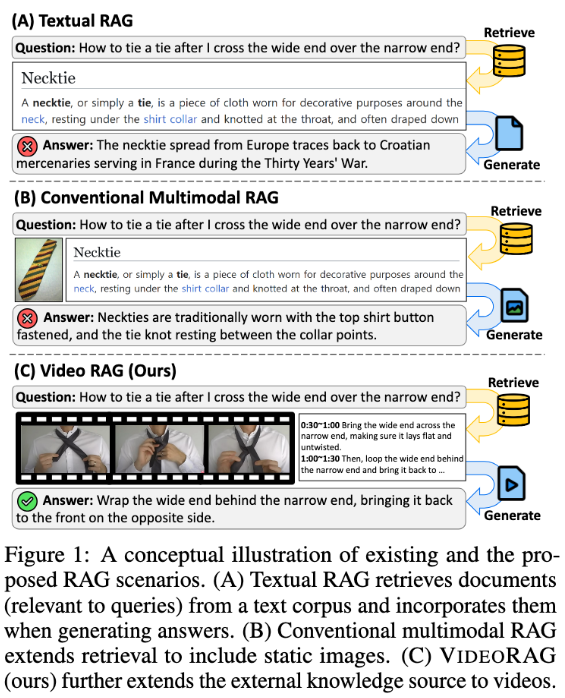With the rapid development of video technology, video has become an important tool for information retrieval and understanding complex concepts. Video combines visual, temporal, and contextual data, providing a multimodal representation that goes beyond static images and text. Today, with the popularity of video sharing platforms and the surge of educational and informational videos, leveraging video as a source of knowledge offers unprecedented opportunities for addressing queries that require detailed background, spatial understanding, and process demonstrations.

However, existing Retrieval-Augmented Generation (RAG) systems often overlook the full potential of video data. These systems typically rely on textual information and occasionally use static images to support query responses, failing to capture the visual dynamics and multimodal cues contained in videos, which are crucial for complex tasks. Traditional methods either predefine relevant videos without retrieval or convert videos into text format, thereby losing important visual context and temporal dynamics, limiting their ability to provide accurate and informative answers.
To address these issues, a research team from the Korea Advanced Institute of Science and Technology (KAIST) and DeepAuto.ai has proposed a novel framework—VideoRAG. This framework can dynamically retrieve videos relevant to queries and integrate visual and textual information into the generation process. VideoRAG leverages advanced Large Video Language Models (LVLMs) to achieve seamless integration of multimodal data, ensuring that the retrieved videos are contextually consistent with the user's query while maintaining the temporal richness of the video content.
The workflow of VideoRAG is divided into two main phases: retrieval and generation. In the retrieval phase, the framework identifies videos similar to the query based on their visual and textual features.

In the generation phase, automatic speech recognition technology is used to generate supplementary text data for videos without subtitles, ensuring that the responses generated from all videos can effectively contribute information. The relevant retrieved videos are further input into the generation module, which integrates multimodal data such as video frames, subtitles, and query text, processed with the help of LVLMs to produce long, rich, accurate, and contextually appropriate responses.
VideoRAG has undergone extensive experimentation on datasets such as WikiHowQA and HowTo100M, with results showing that its response quality significantly outperforms traditional methods. This new framework not only enhances the capabilities of retrieval-augmented generation systems but also sets a new standard for future multimodal retrieval systems.
Paper: https://arxiv.org/abs/2501.05874
Key Points:
📹 ** New Framework **: VideoRAG dynamically retrieves relevant videos and integrates visual and textual information to enhance generation effectiveness.
🔍 ** Experimental Validation **: Tested on multiple datasets, showing significantly better response quality than traditional RAG methods.
🌟 ** Technological Innovation **: Utilizing large video language models, VideoRAG opens a new chapter in multimodal data integration.
